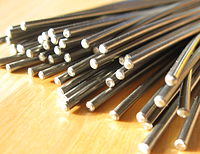
Photo from wikipedia
Abstract The introduction of graded functionality to NiTi shape memory alloy is being pursued to widen martensitic transformation intervals, enhance the controllability and further promote their widespread application as smart… Click to show full abstract
Abstract The introduction of graded functionality to NiTi shape memory alloy is being pursued to widen martensitic transformation intervals, enhance the controllability and further promote their widespread application as smart components. However, it is far away to obtain bulk graded NiTi alloy using current methods. In this work, a repetitive laser processing strategy was designed and employed to manufacture functionally graded NiTi alloy. The highest martensitic transformation interval was measured to be 126.7 ± 0.4 °C. The graded functionality was confirmed to display as the continuous increase in mechanical recoverable strain with regard to the applied strain. Furthermore, the graded functionality is independent upon the processing parameters and loading conditions. The microstructure gradient was characterized with the increased grain size and increased amount of B19’ phase, as well as the variation of interior defects along the gradient direction. This is exactly because of the microstructure gradient that causes the dependence of fracture mechanism on the loading condition. The graded functionality was finally analyzed to derive from swift of deformation mechanisms between the detwinning process of pre-existing B19’ variants and the stress-induced martensitic B19’ phase transformation. This work indeed provides a novel and effective approach to manufacture three-dimensional graded NiTi alloy, which could undertake complex structure design thereby catering to desired functional performance in various areas.
Journal Title: Journal of Materials Processing Technology
Year Published: 2021
Link to full text (if available)
Share on Social Media: Sign Up to like & get
recommendations!